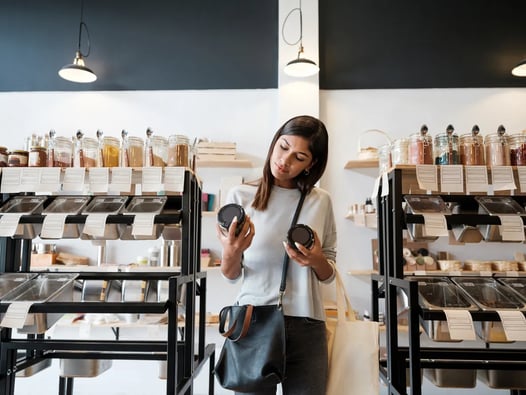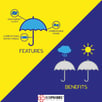Are You Overlooking This Advanced Retail Selling Technique?

Subscribe to our newsletter
One of the most basic elements of any retail sales training program is covering the features and benefits of the product. The feature is a fact you can't dispute; the benefit is what the customer gets from that fact.
You know that already, I hope.
But only a list of features is often heard on the sales floor.
Boring. Boring. Boring.
And overwhelming.
And it frequently and unintentionally trips a customer’s idiot switch.
Customers wonder, Why are they telling me all of this? And meanwhile, the salesperson drowns them in useless fact after useless fact.
An untrained employee uses features like a hunter who shoots a shotgun into the air, hoping a bullet strikes a bird.
But if you truly understand how to sell something in a retail setting, you know the magic only happens when you give the right features to the shopper based on what that shopper told you was important to them.
To ace a full-price, premium item sale and sell it without a discount, you must be able to compare and contrast various products naturally.
I ran across this article, How Expensive Shotgun Shells Save You Money, written by Bill Miller, a hunter, and the writer does a brilliant job of pointing out the benefits of spending more on better ammo.
He's not a salesman; he's a sportsman and a user concerned with educating the client about why you want to purchase more expensive shells.
He shares his wisdom in practical, real-world examples like, "Think about the birds you've lost while shooting "bargain" shells. Every one of us has shot a duck or goose with standard steel, seen it flinch from the hit, but then watched it go on flying as though totally unaffected. Finally, a quarter-mile away, it folds up and drops like a stone in the middle of the thickest cattail slough in the state. Even a world-champion retriever brings back few of those birds. It happens more than we like to remember. It's impossible to put a value on a lost bird."
Or on his final advice when he tells us to "go to your local sporting goods store. You'll see that Federal Black Cloud three-inch Steel #3 costs almost twice as much as the least expensive steel three-inchers in Federal's line (or anybody else's, for that matter). Since the Black Cloud shell significantly boosts your odds of stoning a duck with a single shot versus having to shoot even one more shell to finish each duck you shoot, then you're immediately breaking even with the Black Clouds.".
Whether you are a sports person or not, you read it thinking; I didn't know that, or I've never looked at it that way. And as that customer, you know you will purchase the better, more accurate, more expensive ammo because of the training you received on the products.
Because the benefits make it worth the cost to you, the customer. Those benefits put a face to that product to stand out from other like products - especially those that are cheaper. The higher profit comes with better benefits.
It is the power of compare and contrast in retail selling.
Once your crew can isolate the features of your premium products and connect them to the benefits for each customer, it's time to train those employees on the more advanced retail sales technique of compare and contrast.
Don’t do it before they can reliably describe the features with benefits, or they will get frustrated, and so will you.
Then become a story collector.
To get started, have your salespeople, as they are ringing up each of their customers making a full-price purchase, ask, "Why did you choose this premium item?" (Don't ask about the brand like, "Why did you choose Jimmy Choos or Rolex? Ask about the specific premium item).
Your questions are about the benefits these customers find in the expensive merchandise that makes them willing to spend more money.
You will probably hear them talk about a feature they see as a solution to save them time, trouble, or lost birds in the case of the hunter. Or you could hear about impressing their friends, family, or stubborn in-law.
The more your employees ask for and hear these stories, the more they'll understand the benefits most important to their customers. That gives them the foundation to compare and contrast with future customers. Your crew's learning comes from your customer satisfaction with the products they purchase.
Next, they have to understand that comparing two items begins with similarities.
Here's how to get your salespeople to compare and contrast:
Select one premium item in their department and something wildly cheaper.
For example, if you sell jewelry, choose a wedding band and a paper ring.
If you are a pool store, choose your best above-ground pool and a hole in the lawn.
Choose your premium window covering and a foil roll if you are a window fashion store.
Got the idea?
What you want them to be able to see first is how both items are the same.
This retail selling exercise helps them imagine and play, which is the best learning method. You're building their insight between commonly used words and merchandise they may not sell often.
Have fun with it.
So for the wedding band and paper ring, a salesperson should be able to say how both could be given as symbols of affection, how both are handmade and how both can be sized to an individual.
For the best above-ground pool and a big, deep hole in the lawn, they should be able to say how both hold water, make you cooler when you jump in, and take up the same amount of space.
They should be able to say how both can keep out the sun for the premium window covering and a roll of foil. Both roll up, and both are easily installed.
Once they can do that, you'll want them to contrast the two items.
So for the wedding band and paper ring, they should be able to give the reasons they are different - how you can't wash your hands while wearing a paper ring as it will dissolve, the band of gold will last longer, the less expensive the material may mean the more temporary the relationship.
You get the idea.
Once they can do this easily with most any branded merchandise you give them, choose two of your own products or one of yours and one from one of your competitor retailers. Suggest that they go online or in an app to research the differences.
Don't let them report back a set of features because that's all they'll find. They need to be comfortable adding the reasons a feature is important if you expect them to sell your more profitable merchandise.
Customers care about features to a point, but they care so much more about benefits - especially the benefits to them. What does that feature allow this customer to do, save, or avoid? That's all that really matters to them and is one of the most important skills you need to offer your staff.
That's what you can add to each sales experience in your retail store that an online search cannot - your wisdom for the customer to choose between two items easily. It only happens when retail selling techniques are trained.
See also, How To Upsell - Getting Retail Employees To Do It Even If They Hate It
In Sum
Until your salespeople can compare wildly different products in your retail stores, they probably won't be able to make subtle comparisons between two premium products. That means they'll default to "this one is cheaper" or "this is on sale."
And that's not compelling because there's always someone cheaper...always.
I have over 90 lessons on retail selling techniques that are proven to lift your profits. Check it out below.



